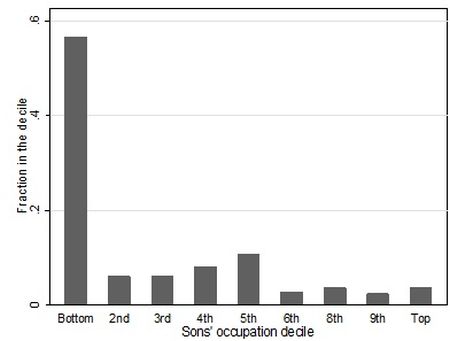While the trade reforms of the 90s led to a rapid increase in trade in India, there are concerns regarding the likely impact of the reforms on inequality. This column shows that innovation induced by international trade led to an increase in the employment share of high-skill occupations, which in turn, allowed an increasing number of sons from underprivileged backgrounds to enter better occupations than their respective fathers.
Once regarded as one of Asia’s least open economies, India experienced a rapid increase in trade following its trade reforms in 1991. We find that the reforms led to a decline in India’s average manufacturing tariffs from 149% in 1990 to 45% by 1998 (Ahsan and Chatterjee 2015). In addition, India’s trade to Gross Domestic Product (GDP) ratio increased from a mere 15% in 1990 to 23% in 1998 (World Development Indicators). However, the growing share of trade has led to concerns about the impact of these reforms on inequality. This is motivated by evidence of the inequality-increasing effects of trade in other developing countries.1 This evidence contradicts the predictions of standard trade theory, which suggests that trade liberalisation should benefit low-skilled labour (the relatively abundant factor of production) in developing countries such as India (Stolper and Samuelson 1941). This mismatch between standard theory and empirical evidence has inspired a variety of models all proposing a relative rise in the demand for skilled labour as an explanation for the rising gap between skilled and unskilled wages.
In a recent paper, we show that this increase in the relative demand for skilled labour also allows trade to raise upward intergenerational occupational mobility, that is, the probability that a son has a higher-ranked occupation than his father (Ahsan and Chatterjee 2015).2
Like father, like son
We examine the relationship between the occupations of fathers and sons using the 55th round (1999-2000) of the nationally representative household surveys collected by the National Sample Survey Organisation (NSSO). A feature of these NSSO data is the collection of detailed occupational categories. In particular, in our working sample, we are able to categorise individuals into 335 highly disaggregated occupations.3 Our data suggest that there is significant persistence in occupational choice in India. As Figure 1 illustrates, conditional on having a father who is at the bottom decile of the fathers’ occupational distribution in 1999, there is a 57% chance that a son in 1999 in our sample is also in the bottom decile of the sons’ occupational distribution. Similarly, we find that, conditional on having a father who is at the top decile of the fathers’ occupational distribution in 1999, there is a 39% chance that a son in 1999 is also in the top decile of the sons’ occupational distribution. This implies that, to the extent that greater trade leads to greater upward occupational mobility in India, it has the potential to significantly improve the lives of workers from underprivileged backgrounds.
Figure 1. Occupational deciles of sons who have fathers in bottom decile of fathers’ occupational distribution
 Source: National Sample Survey (NSS), 55th Round.
Source: National Sample Survey (NSS), 55th Round.
How trade impacted occupational mobility in India
To identify the impact of trade on occupational mobility, we exploit the geographic variation in exposure to trade liberalisation in urban India. In particular, we examine whether, all else equal, a son residing in an urban district with greater exposure to trade liberalisation is more likely to be in an occupation that is higher ranked than that of his father. We define a district’s exposure to trade liberalisation as the change in the weighted average tariffs of all manufacturing industries located in that district between 1987 and 1998. The weights are each industry’s share of a district’s employment in the pre-reform period. Our results suggest that a 10 percentage point decrease in a district’s tariffs increases the likelihood of upward intergenerational occupational mobility among its adult male residents by 1.85 percentage points. We also find no evidence to suggest that an urban district’s exposure to trade has an effect on downward occupational mobility.
To understand this impact of trade on upward intergenerational occupational mobility, we build a model where trade liberalisation leads to an increase in the threat of entry by foreign competitors into the domestic market. As in Aghion et al. (2009), this threat of entry encourages domestic firms that are relatively close to the world technology frontier (high-tech firms) to increase their innovation effort due to the pro-competitive effects of trade. This leads to an increase in the return to skill in such high-tech firms. On the other hand, domestic firms that are further away from the world technology frontier reduce their innovation effort and return to skill due to the discouragement effect of increased threat of entry. Thus, our model predicts that trade-induced competition and innovation will raise the employment share in high-tech firms, which is equivalent to increasing the employment share of high-skill occupations. This will allow a growing number of workers, irrespective of their background, to enter high-skill occupations and thereby experience upward intergenerational occupational mobility.
Does investment in education play a role?
An alternate mechanism that can also explain the occupational mobility-enhancing effects of trade is differential investment in education. For instance, it could be the case that households that invest more in their son’s education as a result of trade are the ones that experience greater upward intergenerational occupational mobility. However, our data suggest otherwise. First, we find that trade does not have a significant effect on the probability that a son has a higher educational attainment than his father. Second, we find that the impact of trade on occupational mobility does not change when we restrict the sample to father-son pairs that have the same educational attainment, that is, pairs where there was no educational mobility.
Interestingly, our results suggest that investment in education only facilitates upward occupational mobility in urban districts with a higher pre-reform concentration of high-tech industries. This suggests that when it comes to intergenerational occupational mobility, investment in education only pays off if there is also a significant increase in the share of high-skill occupations. Thus, while trade does not necessarily lead to greater intergenerational educational mobility in India, it does lead to better occupational outcomes for higher-educated sons provided they live in a district that has had the necessary underlying changes in the distribution of occupations.
Take-aways
Our analysis yields two new results. First, we show that the same mechanism that causes an increase in the skill premium (higher relative demand for skill) also facilitates upward intergenerational occupational mobility. In a dynamic version of our model with occupation-specific inherited knowledge, higher employment opportunity for underprivileged workers in high-tech firms implies lower entry barrier for high-skill occupations in future. This result implies that our understanding of the distributional consequences of trade liberalisation is incomplete without analysing its effect on such mobility. Second, we show that greater investment in education alone need not facilitate intergenerational occupational mobility; it only does so in locations where there has been a sufficiently large increase in the employment share of high-skill occupations. This highlights a complementarity that suggests that education can act as a harbinger of social mobility only if there is a sufficient increase in the demand for skill.
Notes:
- See Goldberg and Pavcnik (2007) for a review of the academic literature on trade and inequality.
- We rank occupations based on the average education of individuals in that occupation in 1987 (pre-reform period). We also rank occupations based on average wages in 1987. Our results remain robust to the use of the wage-based ranking.
- Our working sample consists of 7,791 individuals. Please refer to the paper for further details on the construction of this working sample.
Further Reading
- Aghion, P, R Blundell, R Griffith, P Howitt and S Prantl (2009), “Online Supplement to the Effects of Entry on Incumbent Innovation and Productivity”, The Review of Economics and Statistics, 91(1): 20–32.
- Ahsan, RN and A Chatterjee (2015), ‘Trade Liberalization and Intergenerational Occupational Mobility in Urban India’, UNSW Business School Research Paper No. 2015-23.
- Goldberg, P and N Pavcnik (2007), “Distributional Effects of Globalization in Developing Countries”, Journal of Economic Literature, 45(1): 39–82.
- Stolper, WF and P Samuelson (1941), “Protection and Real Wages”, Review of Economic Studies, 9(1): 58-73.




 18 April, 2016
18 April, 2016 





Comments will be held for moderation. Your contact information will not be made public.